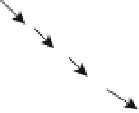Geography Reference
In-Depth Information
This searching process is applied successively to a grid
of IAs on the first image to calculate an instantaneous
vector field. The vector field can then be used to estimate
spatial and temporal features of the flow, such as themean
velocity and streamlines, as well as other velocity-derived
quantities such as vorticity, strain rates, fluxes, and dis-
persion coefficients due to shear for a single image pair.
Displacement vectors from multiple image-pairs can be
averaged to obtain mean velocity vectors.
The cross-correlation coefficient (
R
ab
) was used as the
similarity index (Fujita and Komura, 1992, Fujita et al.,
1998), defined as:
16.3.4 Streamgauging
To compute discharge across a cross-section from the
surface velocities measured by LSPIV, information on the
bathymetry of the channel in the measurement section
and the relation between depth-averaged and surface
velocities is required. The channel bathymetry was mea-
sured prior to the LSPIV measurements using a total
station. It was assumed that the bathymetry was stable.
Surface velocities at several points along the surveyed
cross section (
V
i
) were computed by linear interpolation
from neighbouring grid points of the LSPIV-estimated
surface velocity vector field. Missing velocities along the
wetted width of the cross-sectional profile were inter-
polated or extrapolated by assuming a constant Froude
number across the width of the channel (Fulford and
Sauer, 1986). The depth-averaged velocity at each vertical
was related to the free-surface velocity by a coefficient
(
a
ij
−
a
ij
b
ij
−
b
ij
MX
i
=
1
MY
j
=
1
R
ab
=
MX
b
ij
2
1
/
2
b
ij
−
j
=
1
a
ij
−
a
ij
2
MX
i
=
1
MY
i
=
1
MY
j
=
1
α
) that depends on the shape of the velocity profile.
The coefficient is thus a function of the aspect ratio of
the channel, Froude and Reynolds numbers, micro and
macro bed roughness, and the relative submergence of
large-scale roughness elements. Polatel (2005) showed
that
(16.2)
where
MX
and
MY
are the sizes of the interroga-
tion areas, and
a
ij
and
b
ij
are the distributions of the
grey-level intensities in the two interrogation areas sepa-
rated by the time interval
varied between 0.789 and 0.928 in a series of lab-
oratory experiments with varying velocities over smooth
beds and beds roughened with dunes and ribs. Values of
α
were higher for smooth beds and larger flow depths. A
value of
α
t
. The overbar indicates the
mean value of the intensity for the interrogation area.
To improve measurement accuracy, a sub-pixel fitting
method such as Gaussian or parabolic fitting is applied to
the cross-correlation distribution (Fujita et al., 1998). The
pair of interrogation areas showing the maximum cross-
correlation coefficient is selected as the most likely vector.
The selected image processing algorithm is similar to
theCorrelation ImagingVelocimetry algorithm(Fincham
and Spedding, 1997). Both algorithms use a variance nor-
malised correlation, inwhich each pixel in the IA is equally
weighted, such that the background is just as important as
the particle images. Consequently, the algorithm can esti-
mate velocities from low resolution images, such as those
captured by standard mini-DV video cameras. Another
important feature of the cross-correlation algorithm is
that the interrogation area is decoupled from its fixed
location in the first image to any arbitrary location in
the second image. This process eliminates the velocity
bias error (Adrian, 1991). It also greatly improves the
signal-to-noise ratio in the presence of large displace-
ments, significantly extending the dynamic range of the
velocity measurement. More importantly, the algorithm
allows the use of relatively small sampling areas, which
significantly increases the available spatial resolution and
reduces the errors due to spatial averaging when measur-
ing high-vorticity flows.
Δ
85 is generally accepted by the hydraulic
community for flows in rivers (Costa et al., 2000). The
total discharge across the section was computed following
the standard velocity-area method (Figure 16.2).
α =
0
.
16.3.5 Results
α =
.
Amean value of
90 was calculated from the vertical
velocity profiles measured by the ADCP at a discharge
0
Free-surface velocity
from PIV (
V
s
)
Discharge
calculation
transect
i
= n
i
= 2
i
= 1
Free surface
interpolated
velocity (
V
i
)
Bathymetry from
direct surveys
Depth-averaged
velocity
Figure 16.2
LSPIV-based discharge measurement procedure.






















Search WWH ::

Custom Search